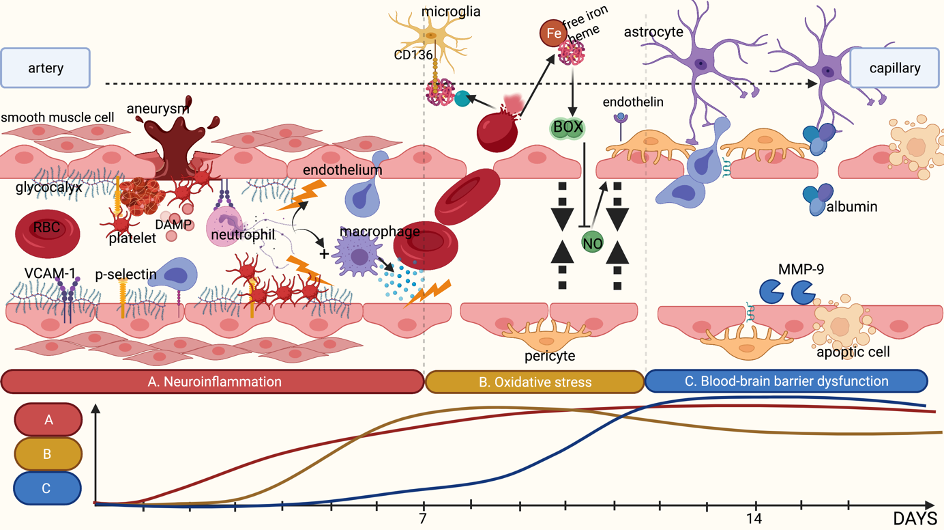Stroke
Crossroad
Research theme: Monitoring
Clinical pillar: Stroke
An aneurysmal subarachnoid hemorrhage (aSAH) is a type of stroke that is caused by rupture of an intracranial aneurysm affecting 6-8 per 100 000 person-years. About 30-45% of SAH patients die within the first 30 days following the hemorrhage. Survivors are prone to severe life-long disabilities and reduced quality of life. Our vascular research group has been focusing on further elucidating the pathophysiology of aSAH-related complications for better prevention of disabilities and reduction in mortality. Moreover, our group aims to determine the best treatment modalities for (ruptured) intracranial aneurysms. Strong collaboration lines with the university hospital of Helsinki, Finland, but also with the Dutch university hospital of Nijmegen, Amsterdam and Leiden, the Netherlands, contribute to achieve our goals.
Unique contributions and highlights
Predicting delayed cerebral ischemia using micro- and macrovascular parameters
Survivors of an aSAH are prone to a severe complication called delayed cerebral ischemia (DCI), occurring in around 30% of all patients. It is defined as a new neurological deficit or decrease in Glasgow Coma Scale of two or more points that cannot be explained by other common complications like meningitis, hydrocephalus or post-operative ischemia. Diagnostic, prognostic and treatment strategies for delayed cerebral ischemia are currently limited.
Our ongoing clinical research involves close monitoring of aSAH patients admitted at the MUMC+, using numerous and novel diagnostic tools and outcome parameters to better understand and predict DCI. We hypothesize that DCI is caused by damage to the glycocalyx, an important structure lining the luminal side of blood vessels involved in regulation of thrombosis, inflammation, and oxidative stress. Moreover, we hypothesize that these changes in glycocalyx integrity are associated with inflammation, and that these processes can be detected by changes in the cerebral blood flow in the afferent larger intracranial arteries. To this end, the glycocalyx is visualized in vivo using side-stream darkfield imaging. The glycocalyx is also indirectly measured by means of specific glycocalyx components in plasma and cerebrospinal fluid of these patients and correlated with levels of inflammatory cytokines and enzymes. At a macrovascular level, transcranial Dopplers are performed regularly to assess changes in blood flow velocity and in signal morphology that could underlie delayed cerebral ischemia.
This clinical research is based on a recent scoping review from our group providing evidence for a possible role of the glycocalyx in the pathophysiology of DCI published in Frontiers in Cell and Developmental Biology (link: article).

Figure: Summary of the different pathophysiological phases contributing to DCI.
Figure and legend reproduced from article by Schenck et al. in Front. Cell Dev. Biol., 03 September 2021 Sec. Signaling’by Biorender under an academic licence.
Minimally invasive endoscopy-guided surgery in patients with spontaneous supratentorial intracerebral hemorrhage
Our research group also participates in the Dutch prospective, multicenter, randomized, open clinical trial on the assessment of minimally invasive endoscopy-guided surgery in patients with spontaneous supratentorial intracerebral hemorrhage (DUTCH-ICH). Currently, most intracerebral hemorrhages are treated conservatively. Minimal invasive endoscopy-guided surgery may improve clinical outcome and enhance recovery of patients suffering from an intracerebral hemorrhage. This study aims to assess the effects of such treatment strategies while comparing with a conservatively treated cohort.
Comparing clipping versus coiling for the treatment of (un)ruptured intracranial aneurysms
Our research group is currently participating in a Dutch prospective multi-center research project (SPARTA: studie naar de prognose van acuut geruptureerde intracraniële aneurysmata) collecting data on aSAH patients to determine the best treatment modalities for ruptured intracranial aneurysms. Outcomes are evaluated for a period of up to 10 years to ensure a long-term follow-up for meaningful results. This research is embedded within a national stroke consortium aimed at improving and standardizing the care of aSAH patients.
Meanwhile, our research group is retrospectively collecting data on all operated (un)ruptured intracranial aneurysms in the last 12 years for an evaluation of patient-related and treatment-related outcomes at our center of expertise. These outcomes will be compared between patients who underwent coiling (endovascular treatment) and patients who underwent clipping (neurosurgical treatment).
Measuring the inter-operability of the modified Rankin Scale (mRS) in subarachnoid hemorrhage patients
Our research group participated in a Dutch prospective multi-center research project evaluating the interoperability of the mRS in aSAH patients. The mRS is widely used as instrument to determine the outcomes of aSAH patients. This study revealed that a patient-reported mRS tended to be higher than a physician-reported mRS and emphasized the need to compare mRS scores with caution considering the high variability (link: article).